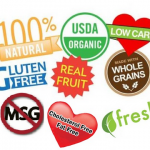 Have you ever bought something you thought was healthy and good for you, only it turned out not to be?
Have you ever bought something you thought was healthy and good for you, only it turned out not to be?
Those are the tricks of marketers slap words like “all natural” and “fat-free” onto foods hoping that in your quest to eat healthy, you’ll buy them (and subconsciously you’ll eat more of them because you think they’re healthy).
I’m blowing the lid off that right now by decoding common nutritional buzzwords. Next time you reach for something you think is healthy, ignore the big bold label on the front, and really pay attention to what’s in the list of ingredients. Hint: if sugar or something you can’t pronounce is in the first five ingredients, put it back right now!
Natural
Just because the word “natural” is on a food label doesn’t instantly make it better or more wholesome. Foods labeled natural may still contain too much sugar or fat.
Organic
While some certified organic food may be quite good for you, organic food production is especially about environmentally sustainable production practices and humane treatment of animals. In the U.S., “organic” food must now be produced and handled according to USDA standards.
Fat-free
Beware that sometimes when fat is removed, additional sugar is added leaving the food still high in calories and low in nutrients.
Sugar-free
Contains less than 0.5g of sugar per serving. Keep in mind that sugar-free doesn’t always mean low calorie. Added starch can bump up the calorie count. Manufacturers also often replace sugar with artificial sweeteners and sugar alcohols such as lactitol, sorbitol and xylitol, which may act as laxatives.
Gluten-free
Just because a product is labeled gluten-free doesn’t mean that it’s good for you. Manufacturers often use more sugar or fat to make these products more palatable, and some gluten-free products contain more calories than their regular counterparts.
Whole grain
This term is misleading because whole grains can contain various blends of grains that are refined. Avoid words like enriched and bleached on the ingredients label. You can only trust the term “100% whole grain” to be a healthy choice.
Multi-grain
This means there is more than one type of grain. Multi-grain has no proven health benefits, especially if all of those grains are refined, and they probably are (unless the ingredients list proves otherwise).
Like this post? Please share with anyone you think needs to know. Or, leave a comment below and tell me what you think.
You'll also receive my Eating for Fat Loss tip sheet with six simple strategies you
can put to use right now.



